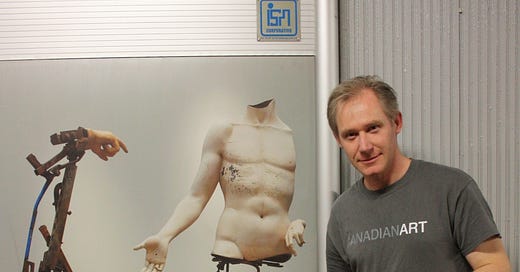It is By-election Day here in the federal riding of Durham, Ontario (March 4th). Many of us have been out one last time, for the final ‘Get the Vote Out’ push, and before we head to the polling stations as Scrutineers this evening, I thought I’d take a few minutes for a new post — unrelated to the election (as there will be plenty to say on this subject after the ballets are counted).
In 2017, I wrote the following short essay for a group art exhibition at the Buckhorn Festival of the Arts. I’ll refer you to an earlier post (‘What is Regionalism’) for more on this project, as I’d like to keep this latest posted as short as possible.
Although this isn’t about the election specifically, it is a commentary on the future of the democratic process; since Modern Democracy depends on there being an engaged middle-class. Not only is the middle class disappearing, engagement in the process may also be reaching all time lows. . . but this is a story for another time.
So let me diverge for a few minutes, into the cultural world — that ‘invisible environment’ which both reflects and shapes everything that happens in the ‘profane’ everyday world.
August, 2017 (Buckhorn, Ontario)
A small 'elite among the middle-class'
As Baby Boomers down size – and a smaller, less-affluent middle-class takes that generation's place – independent art itself is in jeopardy. Free expression is an essential component of free and democratic society, but free expression is not possible without independent art and culture.
In a famous 1939 essay [‘Avant-Garde and Kitsch’] the world's most acclaimed art critic [Clement Greenberg] famously stated that art 'actually belongs' to 'an elite among the ruling class'.
‘The masses have always remained more or less indifferent to culture in the process of development. But today such culture is being abandoned by those to whom it actually belongs-our ruling class. For it is to the latter that the avant-garde belongs.’
He went on to explain [how] this group had 'abandoned' its role in the 'development' of culture for the 'masses', suggesting that the 'ruling class' should once again take back their art. This happened in the early fifties, as the untold history of modern art reveals.
Regionalists, by contrast, believe that art belongs to everyone; and in this cultural struggle, independent art is the resistance. If the society in which we live is truly democratic, then Regionalists might be regarded as the 'official opposition'. Based on this reasoning, a growing number of individuals are acknowledging the importance of independent culture, and helping us develop a model by which future generations of artists may continue the tradition of an ‘art for the people.’
Everyone has a stake in the preservation of a strong and vibrant independent culture, and to this end (we must assume) Canadian Art magazine, in a 2016 article, posed to the Question: 'What should an art movement look like?'
Art movements in the late-modern and postmodern periods might more accurately be described as fashion trends; for in an age of apolitical art, art was not intended to address real world issues or precipitate change. Regional artist however (prior to 1953) regularly made change possible by addressing the interests of the people – without, as some have charged, producing Kitsch.
Artists have traditionally been catalysts of change, but it has been said many time (by numerous commentators) that the aim of postmodernism, from the beginning, was to convert 'active citizens into passive consumers'. This assessment by Eleanor Heartney, in her book Postmodernism (from the ‘Movements In Modern Art’ series), is perhaps the most powerful; for if this is true, a movement in art can no longer gather the support required to make a difference in the wider world.
A small 'elite among the middle-class', therefore, has never been more important, if the tradition of independent regional art is to endure and once again bring about positive change. We hope, therefore, that you will join us in this venture.
Currently available citations (from the original piece) are linked above.
It is as difficult keeping up with developments in the world of culture (as it is in everything else) and to separate ‘the wheat from the chaff,’ the ‘authentic’ from cleverly crafted political ‘nudges.’ As an interesting overview of this, let me direct you to a book I consider essential reading for anyone in the cultural sphere, from a former Editor in Chief of Canadian Art: Curationism: How Curating Took Over the Art World and Everything Else.
A snap shot shared with the author of Curationism, David Balzar, while he was still Deputy Editor in Chief of Canadian Art (in 2015) — from the Mexico City subway.
I met Michael Landy a couple of years later (in 2017) when he was in Toronto for his ‘Demonstration’ project (in which I was happy to participate). The influence of this ‘International’ art is far reaching (as you can see). It represents a kind of totality (as alluded to in the above mentioned book), which excludes everything else as a kind of kitsch (in keeping with Greenberg’s philosophy).
This is where our own cultural project began. . . but I must continue with this later.
Thank you again for your interest and continuing support,
David




